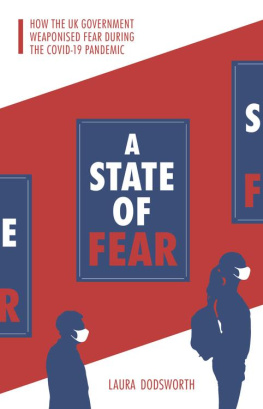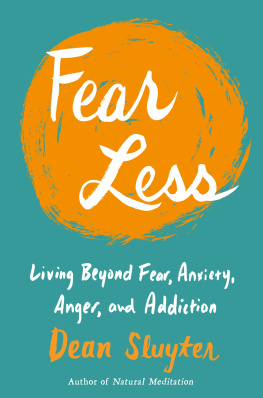Copyright 2020. NYU Press.
Christopher D. Bader, Joseph O. Baker, L. Edward Day, and Ann Gordon
References to Internet websites (URLs) were accurate at the time of writing. Neither the author nor New York University Press is responsible for URLs that may have expired or changed since the manuscript was prepared.
Names: Bader, Christopher, 1969 author.
Title: Fear itself : the causes and consequences of fear in america / Christopher D. Bader, Joseph O. Baker, L. Edward Day, and Ann Gordon.
Description: New York : NYU Press, 2020. | Includes bibliographical references and index.
Identifiers: LCCN 2019006870 | ISBN 9781479864362 (cl : alk. paper) | ISBN 9781479869817 (pb : alk. paper)
Subjects: LCSH: FearUnited States. | United StatesSocial conditions21st century. | United StatesPolitics and government21st century.
New York University Press books are printed on acid-free paper, and their binding materials are chosen for strength and durability. We strive to use environmentally responsible suppliers and materials to the greatest extent possible in publishing our books.
FOREWORD
EARL BABBIE
At first, the study of fear seems a narrowly specific topic for research, but it soon becomes apparent that fear is metastasized throughout many of the volatile issues that shape individual and societal life. This book, drawing on and analyzing the annual Chapman University Survey of American Fears, provides an in-depth and broad-ranging examination of what worries Americans most. And its not what you might think.
Ghosts, zombies, terrorism, and robbery dont even make the top 10. After 242 years of a democratic experiment, Americans are most likely to choose corruption of government officials as something they fear. Perhaps this should come as no surprise. In the news during the last few years, some of the biggest stories have concerned members of Donald Trumps presidential campaign and presidential administration being convicted or pleading guilty to a variety of crimes. Several cabinet members have been charged with ethics violations, and Tom Price and Scott Pruitt were driven from office.
Such scandals did not begin with Donald Trump, however. There are countless examples throughout American history. Watergate and Teapot Dome come to mind. Nor is the pattern of public corruption limited to national politics. Four of the past seven Illinois governors have moved from the State House to the Big House, serving time in prison: three Democrats and one Republican. Corruption is a bipartisan pastime.
The advantage of a longitudinal study like the one on which this book draws is the opportunity to observe changes in American fears over time. For example, in 2018 the fear selected by most respondents (73.6 percent) was the corruption of government officials, as noted earlier. That was also the leading fear in the 2017 survey, selected by roughly the same percentage (74.5 percent). While it was also the leading fear in the 2016 survey, a substantially lower percentage selected it (60.6 percent). It is interesting that this increase occurred during the period that American intelligence services now tell us that Russian trolls on Internet media were not only promoting the candidacy of Donald Trump but were even more interested in sowing distrust of government among American citizens.
The long list of phenomena that Americans fear is only the beginning, however. This books analysis examines who is the most afraid and why. As you might imagine, anxiety, paranoia, and phobias are commonly accompanied by a long list of fears, although the direction of causation is uncertain.
One of the more interesting discoveries lies in the connection between fears and the belief in conspiracy theories. Many Americans have become convinced that we have not been told the truth about such events as 9/11, the Kennedy assassination, the moon landing, Area 51, and on it goes. Alex Jones has convinced some Americans that the Sandy Hook school shooting was made up and that no children actually died. (He is currently being sued by the parents of some of the young victims.)
The most unsettling finding for me was the discovery that a third of the sample believed there was a cover-up regarding the South Dakota crash. You may be unfamiliar with that event since the researchers made it up. There was no South Dakota crash, but one American in three believes there was a cover-up. That discovery put a new fear at the top of my list: a fear of people who believe such things.
By the time you complete this book, you will be amazed by this unusual aspect of American life. Be clear, many things are worthy of our fears. For example, the fear of environmental degradation is high on the list for the Americans sampled in this study. The authors of this book do not intend to dismiss fears altogether. However, they demonstrate the many ways in which some fears can paralyze us and distract us from things actually worth fearing.
Clearly, I have the highest regard for this book, and my assessment is unbiased by the fact that the annual Chapman University Survey of American Fears from which it emerges was a project of the Earl Babbie Research Center. Just a coincidence, perhaps. The book is well worth your time and attention in any event.
Earl Babbie
Campbell Professor of Behavioral Science (Emeritus)
Chapman University
Introduction
On July 1, 2015, Kathryn Steinle was enjoying a walk along Pier 14 with her father and a friend. It was a beautiful day with friends and family, a day without fear.
Then Jim Steinle heard a loud bang. His 32-year-old daughter slumped against him; said, Help me, Dad;
The shot that killed Kathryn had been fired by Jose Inez Garca Zrate, an undocumented immigrant under the influence of sleeping pills he claimed to have found in the garbage. Garca Zrate had been deported from the United States five times and had a criminal record with several felonies, including drug charges and illegal attempts at border crossing. Having been recently caught attempting to cross the border in Texas again, Garca Zrate was passed around the justice system and, by March 2015, sat in jail in San Francisco awaiting a decade-old felony charge of possessing and selling marijuana.
Further heightening the tragic circumstances behind the case, U.S. Immigration and Customs Enforcement (ICE) had requested that Garca Zrate be held until he could be deported once again. But he was released from the San Francisco jail on April 15, 2015, after prosecutors dropped the marijuana charges.
Media outlets made the shooting into a national story, a morality tale on the dangers of illegal immigration, in the run-up to a presidential election.
Part of the reason that Steinles shooting became a cultural touchstone was that it simultaneously tapped into a number of Americas greatest fearsguns, drugs, random acts of violence, illegal immigrants, and a justice system that seems to prioritize criminals over law-abiding citizens. But this simple story of a hardened criminal alien preying on the innocent was, in fact, far more complicated than it first appeared.













